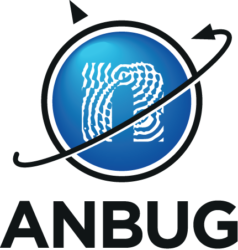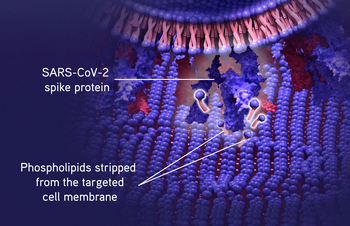Scientists at the Institut Laue-Langevin (ILL), in collaboration with the Paul Scherrer Institut (PSI), the Institut de Biologie Structurale (IBS), using deuterated lipids from ANSTO, have published new data on how the SARS-CoV-2 spike protein interacts with mammalian lung cell membranes allowing the viral RNA to enter human cells. The purpose of the SARS-CoV-2 spike protein is relatively well understood. The glycoprotein is responsible for the fusion event that allows the virus to enter human cells and cause infection and, for this reason, it has been the focus for most COVID-19 vaccines.
Powder Diffraction Beginners Data Analysis Workshop
The Powder Diffraction teams from the Australian Synchrotron and Australian Centre for Neutron Scattering (ANSTO) are hosting a virtual Beginners Data Analysis Workshop from the 17th – 19th August 2021.
This workshop aims to cover all stages of sample analysis, beginning at sample preparation, experimental setup through to wavelength refinement and qualitative and quantitative analysis. Topics will include: basic crystallography, search/matching, indexing, geometry corrections, proposal writing and tips on planning your experiment.
Demonstration sessions will be used to practically reinforce the material presented and will be split into 2 parallel sessions using TOPAS and GSAS II. Priority will be given to applicants with synchrotron or neutron data, or with awarded beamtime.
Lectures and tutorials will be presented by Mr. Ian Madsen (CSIRO), the AS Powder Diffraction (PD) and Advanced Diffraction and Scattering (ADS) beamline teams at the AS, and the Powder Diffraction team at the ACNS, ANSTO. Examples of research carried out at the AS and ACNS will also be presented by Dr. Matilde Saura-Múzquiz (USYD) and Dr. Jack Binns (RMIT).
Location
Online via Zoom.
Date
17 – 19th August 2021
Program
Lectures and demonstrations will be presented. A preliminary programme is available here.
Expressions of Interest
If you are interested in attending, please register an expression of interest here.
The closing date for applications is the 20th July at 11.59pm. Applicants will be informed if they have been successful by COB on the 30th July.
Places are limited to 30 and priority will be given to Early Career Researchers and PhD students with synchrotron or neutron data or who have beamtime allocated.
If there are questions please contact the Workshop Team at this email address: as-pd@ansto.gov.au Please Put “PD Workshop 2021” in the subject line.
200 publications for Quokka!

This year is shaping up to be a record one for publications, with articles in fields as diverse as: food science, magnetic nanocrystals, micelles, polymers, porosity, metallurgy (ancient and modern), complex fluids, protein structure, vortex fluidic flow, meso-scale graphite and much more….
https://neutron.ansto.gov.au/Bragg/proposal/PublicationList.jsp?instr=4&type=1
This method (and its applications) was one of the major reasons for building OPAL in the first place, when the crucial decisions were made in the 1990s. And QUOKKA is just the first of 3 SANS instruments using OPAL’s cold neutrons – the others are BILBY ad KOOKABURRA.
ANBUG Town Hall
On July 20th, 11am-12pm, ANBUG is very happy to host the first in a series of seminars/workshops of general and practical interest to ANBUG members. As we all use neutrons for our experiments, the first seminar focuses on the source of those neutrons.
The talk is entitled:
The OPAL research reactor
presented by Rodney Hall
The OPAL research reactor at ANSTO started operation in 2006. It replaced the HIFAR research reactor which shut down in 2007, in its 50th year. This talk will provide a brief history of HIFAR and then move on to describe the OPAL reactor. This will include an overview of the operation and utilisation of OPAL including details of some of its main components and systems, and how it provides neutrons to the neutron beam experimental facilities.
Rodney Hall is a Nuclear Analyst working at ANSTO for over 19 years. His role is primarily to provide reactor physics support for the operation and utilisation of the OPAL reactor. Rodney has a background in experimental physics. He completed a Bachelor of Technology Honours degree in Optoelectronics in 1996 from Macquarie University. He joined ANSTO in 2002 initially working with the Sulfide Solutions Research Project, principally working on developing instrumentation for the management of mine waste sites. Then in 2003, he took up a position as Reactor Physicist at HIFAR in its final years of operation and was involved with its conversion from HEU to LEU fuel. After HIFAR was shutdown, he moved to the OPAL reactor to work in the Nuclear Analysis Section.
The zoom details will be emailed to ANBUG members. If you have not received this email, please contact Dr. Ben Mallett (ben.mallett@vuw.ac.nz).
2021 National Research Infrastructure Roadmap
Every 5 years the Australian Government reviews and renews its policy approach to national research infrastructure investment referred to as the “National Research Infrastructure Roadmap”.
We encourage the Australian and International neutron scattering community and the wider Australian research community to get involved by completing the 2021 NRI Roadmap Stakeholder Survey to share how you’re currently using ACNS neutron beam instruments, and what you need in the future.
ACNS would appreciate your input to the survey and provide feedback on your current and future needs for neutron scattering.
To assist you we would like you to consider the following when completing the survey:
-The need to maintain ACNS neutron scattering instruments and supporting infrastructure at world-class standard
-The ongoing need for deuteration in neutron scattering and support for the National Deuteration Facility
-Your requirements from ACNS supporting infrastructure such as sample environments, scientific computing, complimentary equipment (X-ray instruments), data management etc.
-New neutron beam instruments and expansion of ACNS neutron beam instruments including the construction of a 2nd Neutron Guide Hall
-International travel support program for Australian researchers to facilitate enable access to neutron capabilities not available in Australia
Please note that the Australian Centre for Neutron Scattering is part of the “Nuclear Science Facilities (NSF)” NRI (question 10).
Apologies for the short notice – the survey closes on Wednesday 30th June.
Please complete the survey here: https://2021nriroadmap.dese.gov.au/get-involved/complete-the-survey/
ACNS Scatter Matters Newsletter
Some of our ANBUG members may not be aware that ACNS has their own regular newsletter, Scatter Matters.
If you’re not already receiving them, or would like to look at the past issues, please visit: https://www.ansto.gov.au/subscribe-to-scatter-matters
ACNS and NDF impact awards – Enter by 16th July
The Australian Centre for Neutron Scattering (ACNS) and National Deuteration Facility (NDF) have announced their inaugural Impact awards.
They are offering prizes for explanations of what impacts your results with our facilities have had. Up to nine prizes, valued at up to $200 are on offer.
For details on how to enter and eligibility visit:
https://www.ansto.gov.au/whats-on/acns-and-ndf-impact-awards
Neutron User Survey
2021 is an important year for ANBUG users as the federal governement will develop the Australian Governement Research Infrastructure Roadmap, ANSTO will develop its Decadal Plan and ACNS is to start up its expansion planning on the Second Guide Hall. Feedback from our ANBUG members is extremely valuable! It is our opportunity to shape Australia’s future research facility that can provide sustainable and state-of-the art support for our research. Because of this, the ANBUG Executive Committee encourages all members and people who care and interested Australian Neutron Science and Technology to participate in this 10 -15 minutes survey.
The survey can be done through the link below
https://www.surveymonkey.com/r/ZD5ZDSB
It will be open for 4 weeks until Friday 2nd July.
The majority of the questions are intended for ACNS users, but if you are not a previous ACNS user and have suggestions on specific instruments, their resolution or other technical capabilities that you feel are currently missing, then we want to hear from you too!
Please forward this survey to anyone you think may be interested or through relevant networks
If you are interested in joining a specific working group focused on developing new neutron facilities, please email us at secretary@anbug.net.
ACNS Sample Environment Equipment Handbook
The Australian Centre for Neutron Scattering (ACNS) at ANSTO has developed a comprehensive resource in their Sample Environment Handbook.
This manual is designed to give you information about their sample environment equipment to help you choose the best fit for the parameters you want to achieve.
ACNS offers a large range of equipment across multiple neutron beam instruments, which can make choosing difficult, as there are a number of sample environment options to achieve similar parameters on each neutron beam instrument.
The handbook is available at: https://www.ansto.gov.au/sites/default/files/2021-01/se_manual_06_01_21-compressed.pdf
Australian AONSA Prize Winners
A lot of our ANBUG members might not be aware that we are a member of the Asia-Oceania Neutron Scattering Association (AONSA). Please check out their website (http://aonsa.org/) if you’d like to learn more!
This year, three ANBUG members, Dr Teng Lu, Dr. Rezwanul Haque and Prof. Rob Robinson, were awarded AONSA prizes!
Dr Teng Lu, from ANU, was awarded a 2021 AONSA Young Research Fellowship. The title of his fellowship is “The order-disorder feature and lattice dynamics in silver niobate-based materials” and will be hosted by the J-PARC proton accelerator facility in Japan.
Dr. Rezwanul Haque, from the University of the Sunshine Coat, was also awarded a 2021 AONSA Young Research Fellowship. The title of his fellowship is “Exploring the mechanical properties of Pb-free SAC-305 solder with Bi additions” and will be hosted by the China Spallation Neutron Source (CSNS).
Prof Rob Robinson was awarded the 2021 AONSA prize “For his outstanding achievements in understanding magnetism of actinide and heavy-fermion materials using neutron scattering, seminal contributions in building the world-leading neutron facility in Australia, and continuous dedication for the promotion of neutron science in the Asia-Oceania region“
ANBUG congratulates Teng, Rezwanul and Rob for their AONSA awards!




